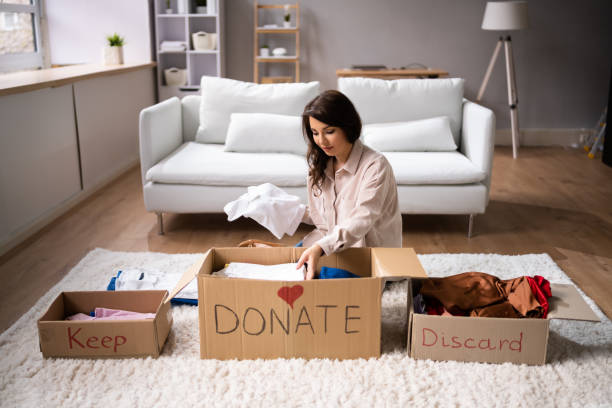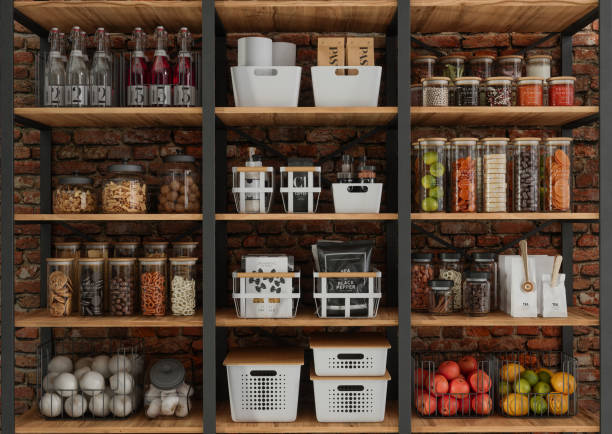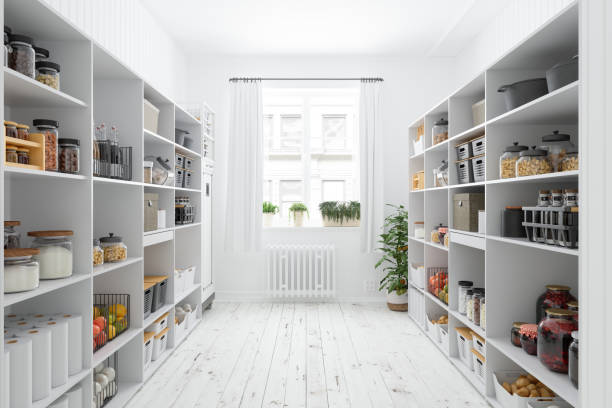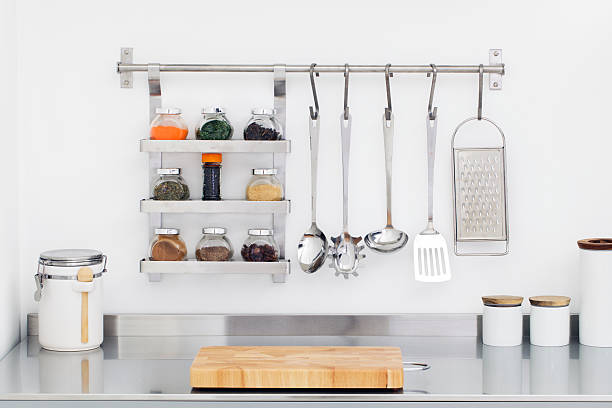An organized home can be a true game-changer, reducing stress, boosting productivity, and making your living space feel more inviting and comfortable. However, the idea of professional organization services can feel out of reach for many, with costly price tags that put a tidy, functional home seemingly out of grasp.
The good news is, that with the right strategy and a little elbow grease, you can achieve an organized abode without breaking the bank. In today’s fast-paced world, our homes can quickly become cluttered and chaotic, filled with accumulations of stuff we no longer need or use. This clutter not only adds visual stress but can also negatively impact our mental well-being, making it harder to focus and feel at ease in our own living spaces.
By taking the time to thoughtfully organize your home, you can transform your space into a calming oasis that sets you up for success. But where do you even begin when funds are limited? The key is to approach home organization methodically, leveraging smart strategies and budget-friendly solutions to create the tidy, functional environment you crave.
In this comprehensive guide, we’ll walk you through the steps to assess your needs, declutter with intention, maximize your existing storage, build custom organization systems on a shoestring, and maintain your organized home for the long haul. By the end, you’ll have the tools and know-how to create an organized, functional, and serene living environment that truly reflects your lifestyle and needs – all while staying well within your budget.
Organize Your Home Without Breaking the Bank
An organized home can be a game-changer, reducing stress, boosting productivity, and making your living space feel more inviting and comfortable. However, professional organization services can be costly, putting a tidy, functional home out of reach for many. The good news is, that with the right strategy and a little elbow grease, you can achieve an organized abode without spending a fortune.

In today’s fast-paced world, our homes can quickly become cluttered and chaotic, filled with accumulations of stuff we no longer need or use. This clutter not only adds visual stress but can also negatively impact our mental well-being, making it harder to focus and feel at ease in our own living spaces. By taking the time to thoughtfully organize your home, you can create a calming oasis that sets you up for success.
But where do you even begin when funds are limited? The key is to approach home organization methodically, leveraging smart strategies and budget-friendly solutions to transform your space without depleting your savings. In this comprehensive guide, we’ll walk you through the steps to assess your needs, declutter with intention, maximize your existing storage, build custom organization systems on a shoestring, and maintain your organized home for the long haul.
By the end, you’ll have the tools and know-how to create an organized, functional, and serene living environment that truly reflects your lifestyle and needs – all while staying well within your budget.
Assess Your Needs and Make a Plan
The first step to getting your home organized on a budget is to take a comprehensive look at your living space and identify the problem areas. What rooms or spaces feel the most cluttered? Where do you waste the most time searching for misplaced items? Jot down your organizational goals, whether that’s decluttering, creating more storage, or improving the overall flow and functionality of your home.

Next, develop a room-by-room plan of attack. Consider factors like:
- Which spaces will have the biggest impact on your daily life and productivity? Start there.
- What storage solutions do you already have that can be optimized through simple tweaks or reorganization?
- Where do you need to invest in new organization systems, and how can you tackle those projects cost-effectively?
Tackling your home methodically, one area at a time, will help ensure you don’t get overwhelmed and maintain steady progress. It’s also a good idea to enlist the help of family members or roommates, dividing and conquering the work to make the process go more quickly.
When assessing your needs, be sure to consider the unique characteristics and challenges of each room. For example, the kitchen may require more vertical storage solutions to maximize cabinet and counter space, while the bedroom may benefit from decluttering and streamlining your wardrobe. By taking a tailored approach, you can develop an organization plan that truly addresses the pain points in your living environment.
As you make your plan, don’t forget to leave room for flexibility. Home organization is an ongoing process, and you may discover new needs or opportunities as you work through each space. Stay open to adjusting your strategy as you go, and celebrate small victories along the way. Even completing one drawer or shelf can provide a sense of momentum and encouragement to keep pushing forward.
Declutter and Purge with Purpose
Effective decluttering is the foundation of an organized home. It’s important to approach this process with intention, thoughtfully evaluating each item to determine whether it truly serves a purpose or brings you joy. Adopt the “spark joy” principle popularized by organizing guru Marie Kondo – if an item doesn’t enhance your life in a meaningful way, it’s time to let it go.

As you go through your belongings, sort them into three piles: keep, donate, and trash. Be ruthless, but also give yourself permission to hold onto the items that truly matter to you. The goal is to cultivate a living space filled with only the essentials, not an overwhelming collection of stuff.
When tackling clutter in different rooms, consider these targeted strategies:
Kitchen:
- Purge expired foods, unneeded gadgets, and duplicate items taking up valuable real estate.
- Organize your pantry, categorizing items by type (baking, canned goods, snacks, etc.) and storing them in clear, labeled containers.
- Maximize cabinet and drawer space with organizers, dividers, and stackable storage solutions.
Bedroom:
- Minimize clothes, linens, and decor you no longer use or love. Be ruthless in paring down your wardrobe.
- Store out-of-season items under the bed or in top closet shelves to free up daily-use space.
- Invest in slim, space-saving hangers to keep your closet tidy and organized.
Home Office:
- Digitize documents, recycle old files, and organize your remaining paper trail in labeled binders or file folders.
- Corral office supplies in desk drawers, bins, or wall-mounted organizers.
- Clear the clutter from your desktop, keeping only the essentials within reach.
Living Room:
- Neatly arrange books, magazines, and media on shelves or in baskets.
- Minimize decorative items, keeping surfaces clear and streamlined.
- Use storage ottomans, side tables with drawers, or bookcases to conceal clutter.
Bathrooms:
- Toss expired toiletries, medications, and personal care products.
- Maximize cabinet and vanity space with organizers, dividers, and lazy susans.
- Hang over-the-door organizers or install shelving above the toilet for extra storage.
By systematically decluttering each area of your home, you’ll not only free up physical space but also mental space. The sense of lightness and clarity you’ll experience can be truly transformative.
Maximize Existing Storage Space
Before investing in new storage solutions, look for ways to better utilize the space you already have. This can involve installing shelves, racks, and organizers to maximize vertical space, optimizing drawers and cabinets with inserts and dividers, and even repurposing common household items in clever ways.

One of the easiest and most cost-effective ways to boost storage is by installing shelving units. Wall-mounted shelves, freestanding bookcases, and modular storage systems can provide ample space for organizing everything from books and decor to pantry items and cleaning supplies. Be mindful of the dimensions of each room and choose shelving that fits seamlessly into the available space.
Another game-changer is optimizing your drawers and cabinets with inserts, dividers, and stackable bins. These organizational tools help you make the most of every nook and cranny, keeping contents visible and accessible. In the kitchen, consider installing a lazy susan in corner cabinets or adding sliding drawers to base units. In the bedroom, use drawer organizers to sort socks, underwear, and other small items.
Don’t overlook opportunities to repurpose common household items for storage as well. A hanging shoe organizer can keep bathroom essentials tidy, while a tension rod can create extra storage space under the sink. Get creative with baskets, crates, and bins to corral everything from toys to craft supplies.
The key is to approach each room with an eye for underutilized areas and think outside the box. By maximizing the storage potential of what you already have, you can create a more organized living environment without spending a lot of money on new organization systems.
Build Custom Organization Solutions on a Budget
If you do need additional storage, you don’t have to break the bank to achieve your goals. DIY projects like building your own shelves, racks, or storage units can be incredibly cost-effective, allowing you to tailor solutions to your specific needs and space constraints.

Before diving into any DIY endeavors, take the time to assess your skill level and comfort with various tools and construction techniques. If you’re a complete novice, start with simple projects that require minimal tools and expertise, such as:
- Hanging pegboards to organize tools, craft supplies, or kitchen items
- Attaching shower curtain hooks to a rod for easy clothing storage
- Transforming cardboard boxes or milk crates into makeshift drawers
As you gain confidence, you can tackle more complex DIY organization projects, such as:
- Building custom shelving units out of inexpensive materials like plywood or even repurposed wood
- Constructing a versatile storage bench or ottoman with built-in compartments
- Creating a custom closet system with hanging rods, shelves, and drawers
Don’t be afraid to scour discount stores, thrift shops, and online marketplaces for inexpensive organization products as well. You’d be surprised by the hidden gems you can find, from plastic bins and baskets to stylish woven storage solutions. With a little creativity and a discerning eye, you can create a cohesive, high-end look on a shoestring budget.
Additionally, consider repurposing items you already own in new ways. An old dresser can be transformed into a bathroom vanity with the addition of a vessel sink, while a vintage trunk makes for a unique coffee table with hidden storage space.
The key is to approach each organization challenge with an open mind and a willingness to explore budget-friendly options. By blending smart DIY projects with strategic thrifting, you can craft custom storage solutions that maximize your space and elevate your home’s aesthetic – all while staying well within your means.
Maintain an Organized Home Long-Term
Achieving an organized home is one thing, but sustaining it is another challenge altogether. It’s all too easy for clutter to slowly creep back in, undoing all your hard work. The key to maintaining an orderly living space is to develop consistent habits and routines that keep chaos at bay.

Start by incorporating quick tidy-up sessions into your daily schedule. Spend just 5-10 minutes each night doing a quick sweep of your home, putting away stray items, wiping down surfaces, and ensuring everything is in its proper place. This simple practice can go a long way in preventing the buildup of clutter.
Next, establish a system for regularly purging unwanted items. Whether it’s a monthly decluttering session or a seasonal cleaning ritual, make it a point to re-evaluate your belongings and let go of anything that no longer serves you. This could involve donating gently used items, recycling outdated paperwork, or simply tossing things that have reached the end of their lifespan.
Don’t forget to enlist the support of your family members or roommates as well. Home organization is a team effort, and getting everyone on board can make the process infinitely easier. Assign specific organization tasks to each person, establish shared expectations for maintaining tidy shared spaces, and make it a habit to do regular clean-ups together.
Additionally, consider investing in organizational tools and storage solutions that inherently encourage tidiness. Lidded bins, labeled drawers, and shelving systems with designated “homes” for your belongings can all help reinforce good habits. The more you can automate the organization process, the less mental energy it will require in the long run.
With a little consistency and mindfulness, you can enjoy the benefits of an orderly, stress-free living space for years to come. By making organization a part of your everyday routine, it will eventually become second nature – and the positive impact on your productivity, mental well-being, and overall quality of life will be well worth the effort.
Frequently Asked Questions
Q: Why is it important to have an organized home?
A: An organized home can provide numerous benefits, including reduced stress, increased productivity, and a greater sense of calm and control in your living environment. When your space is tidy and streamlined, it’s easier to find what you need, complete daily tasks efficiently, and feel at ease in your surroundings.
Q: Isn’t professional organization help too expensive for my budget?
A: You’re right that professional organizers can come with a hefty price tag. However, with the right strategies and a bit of elbow grease, you can achieve a beautifully organized home on your own without breaking the bank. This guide will show you how to leverage budget-friendly solutions and DIY projects to transform your living space.
Q: Where should I start when trying to organize my home? A: The key is to take a methodical, room-by-room approach. Begin by assessing your needs and identifying the problem areas in your home. Then, develop a plan for tackling each space, starting with the areas that will have the biggest impact on your daily life. Remember to declutter with intention, maximize your existing storage, and build custom solutions as needed.
Q: How can I maintain an organized home long-term?
A: Sustaining an organized living space requires developing consistent habits and routines. Incorporate quick daily tidy-ups, schedule regular decluttering sessions, and get your entire household involved in the organization process. Automating organization through smart storage solutions can also go a long way in keeping clutter at bay.
Conclusion
In today’s fast-paced world, a organized, decluttered home can be a true oasis – a haven that reduces stress, boosts productivity, and enhances your overall quality of life. But achieving that ideal living space doesn’t have to come at a premium price tag.
By approaching home organization methodically and leveraging budget-friendly strategies, you can transform your living environment without depleting your savings. Start by thoroughly assessing your needs and developing a room-by-room plan of attack. Then, dive into the decluttering process with intention, purging items that no longer serve you to create a foundation for lasting organization.
Next, look for ways to maximize your existing storage capabilities through smart shelving, drawer organizers, and clever repurposing of everyday items. If you do need to invest in new storage solutions, consider DIY projects and thrifty finds to build custom systems tailored to your space and needs.
Finally, establish routines and habits to maintain your organized home over the long haul. Enlist the support of your family, automate organization processes where possible, and make tidiness a consistent part of your daily life.
With a little elbow grease and a lot of creativity, you can achieve the organized, functional, and serene living environment you crave – all while staying well within your budget. So what are you waiting for? It’s time to take charge of your space and reclaim the calm, clarity, and comfort of an organized home.
If you have any doubts or queries, feel free to write to us. It would be a great pleasure to help you out.
